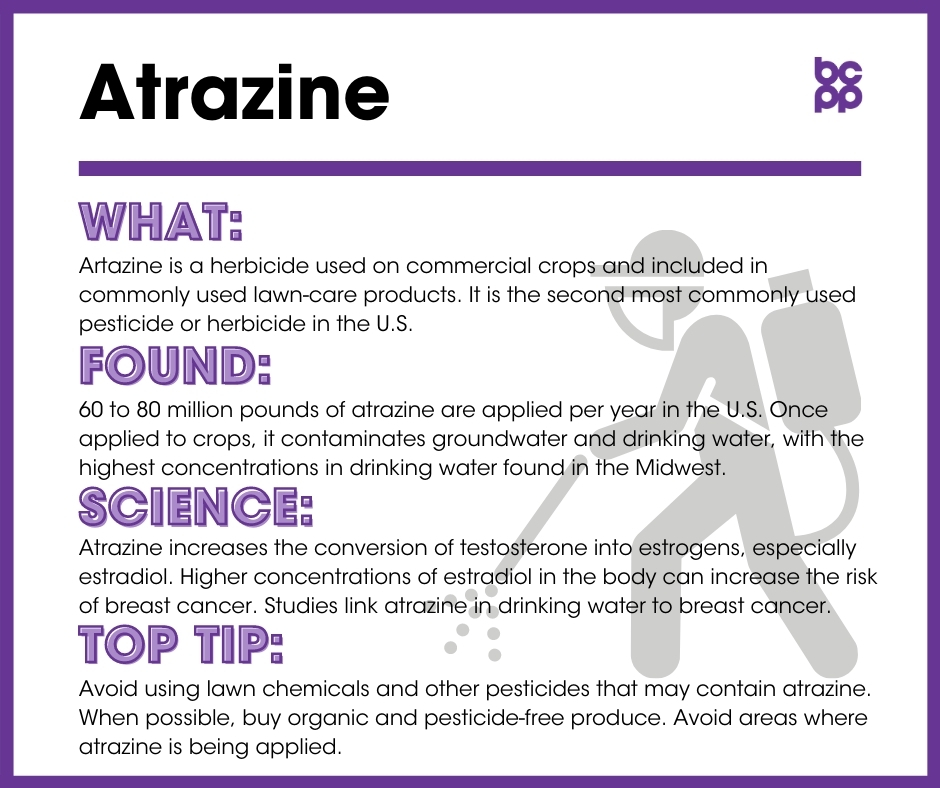Atrazine
At a Glance
Atrazine is an herbicide used in the United States to kill broadleaf and grassy weeds. It is primarily used in commercial agriculture, but can also be used to control weeds in residential lawns and on golf courses.
Atrazine is an endocrine disruptor, and exposure to atrazine has been associated with an increased risk of developing breast cancer.
What is atrazine?
Atrazine is part of the triazine family of herbicides. Other chemicals in the triazine family include simazine, propazine and cyanazine. It is used primarily on commercial crops, such as corn, sorghum and soybeans, but it is also a common ingredient in chemical lawn-care applications used to kill weeds on residential lawns, golf courses, and municipal areas such as railroad rights-of-way and highway medians.[1],[2] Use of atrazine was banned in the European Union in 2005; however it is still approved for use in the United States,1 where it remains the second most applied pesticide behind glyphosate (i.e., Roundup).[3]
Where is atrazine found?
Some 60 to 80 million pounds of atrazine are applied per year in the United States.[4] Once applied to crops, atrazine can migrate into and contaminate groundwater and drinking water.[5],[6],[7] Monitoring studies have shown that the highest levels of atrazine contamination in drinking water occur in the Midwest, where application rates are higher due conventional to farming practices.[8]
What evidence links atrazine to breast cancer?
All triazines have been found to cause breast cancer in laboratory rats,[9] but only atrazine has been well studied for its relationship to breast cancer in humans. There is some evidence linking exposure to atrazine in drinking water with increased incidence of breast cancer.[10] Animal studies have shown that exposure to atrazine may increase the incidence of mammary tumors by disrupting endocrine-signaling pathways.[11],[12]Atrazine has been shown to increase the conversion of testosterone and other androgens into estrogens, especially estradiol, by increasing the activity of the enzyme aromatase,[13],[14] which is responsible for the conversion. Increased concentrations of estradiol in the body can increase the risk of breast cancer.
The fact that atrazine uses the aromatase pathway to increase estrogen production is important, because it means the chemical could work directly against aromatase inhibitors, a class of drugs used to treat breast cancer. Exposure to atrazine while taking aromatase inhibitors for treatment of breast cancer could decrease the efficacy of the drug. Atrazine has also been shown to have dramatic effects on the reproductive structures of frogs, fish, and other wildlife.[15],[16]
Who is most likely to be exposed to atrazine?
People are at risk of atrazine exposure anywhere it is applied. Agricultural workers and other pesticide applicators (e.g., residential lawn and garden workers, groundskeepers for golf courses) are at greatest risk for exposure to atrazine. Atrazine can contaminate groundwater and drinking water; therefore people living in areas where atrazine is used, such as agricultural regions, may also be at risk of exposure. People living on or near residential and municipal areas where atrazine is applied can be exposed if they come in contact with those treated areas.[17]
Who is most vulnerable to the health effects of atrazine?
Scientific evidence suggests that people with existing breast tumors are vulnerable to the effects of atrazine exposure, because atrazine may increase the rate of cell proliferation in existing estrogen-receptor-positive breast tumors, due to its capacity to convert androgens to estrogens.[18] In animal models, studies have also shown that exposure to atrazine both early and late in pregnancy can have developmental effects on mammary tissue in the exposed fetus that can persist into adulthood.[19],[20]
What are the top tips to avoid exposure to atrazine?
- Avoid agricultural and other areas where atrazine is being actively applied.
- Be sure to follow manufacturer instructions on amount of time to avoid treated areas before reentry.
- Avoid using lawn chemicals and other pesticides that may contain atrazine around your home.
- Plant native grasses and use integrated pest management approaches to help control weeds and other pests around your home.[21]
- Buy organic or pesticide-free produce from your local store or farmer’s market to encourage organic and pesticide-free agricultural practices and discourage use of dangerous pesticides that can impact our health and the health of our environment![22],[23]
Reviewed 2019
[2] United States Environmental Protection Agency. “CADDIS Volume 2: Herbicides.” Last modified June 27, 2019. https://www.epa.gov/caddis-vol2/caddis-volume-2-sources-stressors-responses-herbicides#checklist.
[3] Fishel, F. “Pesticide Use Trends in the U.S.: Agricultural Pesticides.” EDIS 4 (2007). https://journals.flvc.org/edis/article/view/116445/114596.
[4] National Resources Defense Council (NRDC). “Poisoning the well: How EPA is ignoring atrazine contamination in surface and drinking water in the central United States.” (2009). Accessed October 23, 2020. https://www.nrdc.org/health/atrazine/files/atrazine.pdf.
[5] Hua, Wen Yi, Erin R. Bennett, Xui‐Sheng Maio, Chris D. Metcalfe and Robert J. Letcher. “Seasonality effects on pharmaceuticals and S-triazine herbicides in wastewater effluent and surface water from the Canadian side of the upper Detroit River.” Environmental Toxicology and Chemistry 25 (2006): 2356–2365. doi:10.1897/05-571R.1.
[6] Miller, Sondra M., Clyde W. Sweet, Joseph V. DePinto, and Keri C. Hornbuckle. “Atrazine and Nutrients in Precipitation: Results from the Lake Michigan Mass Balance Study.” Environmental Science & Technology 34, 1 (2000): 55-61. doi:10.1021/es990486n.
[7] Villanueva, C M et al. “Atrazine in municipal drinking water and risk of low birth weight, preterm delivery, and small-for-gestational-age status.” Occupational and Environmental Medicine 62, 6 (2005): 400-5. doi:10.1136/oem.2004.016469.
[8] Pesticide Action Network. “Atrazine.” Accessed October 23, 2020. http://www.panna.org/resources/atrazine.
[9] O’Connor, John C., David R. Plowchalk, Carolyn S. Van Pelt, Leonard G. Davis and Jon C. Cook. “Role of prolactin in chloro-S-triazine rat mammary tumorigenesis.” Drug and Chemical Toxicology 23:4 (2000): 575-601. doi:10.1081/DCT-100101972.
[10] Kettles, M.A, Browning, S.R., Prince, T.S., et al. “Triazine herbicide exposure and breast cancer incidence: An ecological study of Kentucky counties.” Environmental Health Perspectives 105: 11 (1997): 1222-1227. doi:10.1289/ehp.971051222.
[11] Cooper, R L et al. “Atrazine disrupts the hypothalamic control of pituitary-ovarian function.” Toxicological Sciences: an Official Journal of the Society of Toxicology 53: 2 (2000): 297-307. doi:10.1093/toxsci/53.2.297.
[12] O’Connor, John C., David R. Plowchalk, Carolyn S. Van Pelt, Leonard G. Davis and Jon C. Cook. “Role of prolactin in chloro-S-triazine rat mammary tumorigenesis.” Drug and Chemical Toxicology 23:4 (2000): 575-601. doi:10.1081/DCT-100101972.
[13] Fan, WuQiang et al. “Atrazine-induced aromatase expression is SF-1 dependent: implications for endocrine disruption in wildlife and reproductive cancers in humans.” Environmental Health Perspectives 115, 5 (2007): 720-7. doi:10.1289/ehp.9758.
[14] Sanderson, J T et al. “Effects of chloro-s-triazine herbicides and metabolites on aromatase activity in various human cell lines and on vitellogenin production in male carp hepatocytes.” Environmental Health Perspectives 109, 10 (2001): 1027-31. doi:10.1289/ehp.011091027.
[15] Hayes, Tyrone et al. “Atrazine-induced hermaphroditism at 0.1 ppb in American leopard frogs (Rana pipiens): laboratory and field evidence.” Environmental Health Perspectives 111, 4 (2003): 568-75. doi:10.1289/ehp.5932.
[16] Rohr, Jason R, and Krista A McCoy. “A qualitative meta-analysis reveals consistent effects of atrazine on freshwater fish and amphibians.” Environmental Health Perspectives 118, 1 (2010): 20-32. doi:10.1289/ehp.0901164.
[17] Agency for Toxic Substances and Disease Registry. “Toxicology Profile: Atrazine.” Last modified March 3, 2011. http://www.atsdr.cdc.gov/substances/toxsubstance.asp?toxid=59.
[18] Ueda, M., Imai, T., Takizawa, T., Onodera, H., Mitsumori, K., Matsui, T. and Hirose, M. “Possible enhancing effects of atrazine on growth of 7,12‐dimethylbenz(a) anthracene‐induced mammary tumors in ovariectomized Sprague–Dawley rats.” Cancer Science 96 (2005): 19-25. doi:10.1111/j.1349-7006.2005.00008.x.
[19] Enoch, Rolondo R et al. “Mammary gland development as a sensitive end point after acute prenatal exposure to an atrazine metabolite mixture in female Long-Evans rats.” Environmental Health Perspectives 115,4 (2007): 541-7. doi:10.1289/ehp.9612.
[20] Rayner, Jennifer L et al. “Adverse effects of prenatal exposure to atrazine during a critical period of mammary gland growth.” Toxicological Sciences: an Official Journal of the Society of Toxicology 87,1 (2005): 255-66. doi:10.1093/toxsci/kfi213.
[21] Pesticide Action Network. “Garden.” Accessed October 23, 2020. http://www.panna.org/starting-home/garden.
[22] Environmental Working Group. “EWG’s 2020 Shopper’s Guide to Pesticides in Produce: Dirty Dozen.” Accessed October 23, 2020. https://www.ewg.org/foodnews/dirty-dozen.php.
[23] Environmental Working Group. “EWG’s 2020 Shopper’s Guide to Pesticides in Produce: Clean Fifteen.” Accessed October 23, 2020. https://www.ewg.org/foodnews/clean-fifteen.php.






